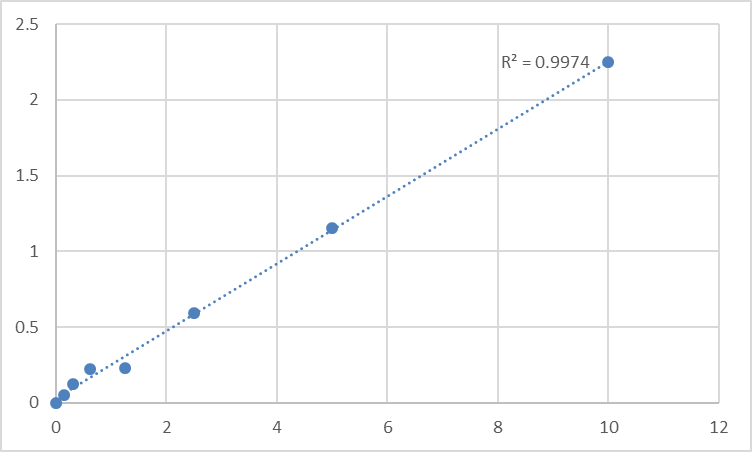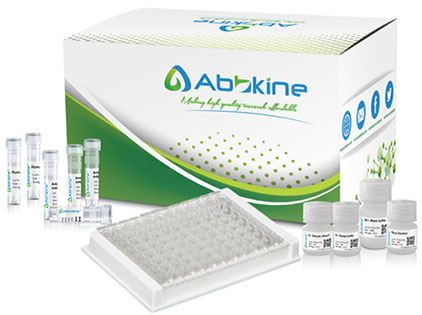| Product name | Human Serum deprivation response (SDPR) ELISA Kit |
| Reactivity | Human |
| Applications | ELISA |
| Applications notes | This Human Serum deprivation response (SDPR) ELISA Kit employs a two-site sandwich ELISA to quantitate SDPR in samples. An antibody specific for SDPR has been pre-coated onto a microplate. Standards and samples are pipetted into the wells and anySDPR present is bound by the immobilized antibody. After removing any unbound substances, a biotin-conjugated antibody specific for SDPR is added to the wells. After washing, Streptavidin conjugated Horseradish Peroxidase (HRP) is added to the wells. Following a wash to remove any unbound avidin-enzyme reagent, a substrate solution is added to the wells and color develops in proportion to the amount of SDPR bound in the initial step. The color development is stopped and the intensity of the color is measured. |
| Detection method | Colorimetric |
| SampleType | Cell culture supernatants, Other biological fluids, Plasma, Serum |
| Assay type | Sandwich ELISA (quantitative) |
| Assay duration | Multiple steps standard sandwich ELISA assay with a working time of 3-5 hours. It depends on the experience of the operation person. |
| Alternative | SDPR; PS-p68; SDR; cavin-2; phosphatidylserine binding protein; serum deprivation response (phosphatidylserine-binding protein); serum deprivation response protein |
| Kit components | • Human Serum deprivation response microplate • Human Serum deprivation response standard • Human Serum deprivation response detect antibody • Streptavidin-HRP • Standard diluent • Assay buffer • HRP substrate • Stop solution • Wash buffer • Plate covers |
| Features & Benefits | Human Serum deprivation response (SDPR) ELISA Kit has high sensitivity and excellent specificity for detection of Human SDPR. No significant cross-reactivity or interference between Human SDPR and analogues was observed. |
| Calibration range | Please inquire |
| Limit of detection | Please inquire |
| Usage notes | • Do not mix components from different kit lots or use reagents beyond the kit expiration date. • Allow all reagents to warm to room temperature for at least 30 minutes before opening. • Pre-rinse the pipet tip with reagent, use fresh pipet tips for each sample, standard and reagent to avoid contamination. • Unused wells must be kept desiccated at 4 °C in the sealed bag provided. • Mix Thoroughly is very important for the result. It is recommended using low frequency oscillator or slight hand shaking every 10 minutes. • It is recommended that all samples and standards be assayed in duplicate or triplicate. |
| Storage instructions | The unopened kit should be stored at 2 - 8°C. After opening, please store refer to protocols. |
| Shipping | Gel pack with blue ice. |
| Precautions | The product listed herein is for research use only and is not intended for use in human or clinical diagnosis. Suggested applications of our products are not recommendations to use our products in violation of any patent or as a license. We cannot be responsible for patent infringements or other violations that may occur with the use of this product. |
| Background | SDPR encodes a calcium-independent phospholipid-binding protein whose expression increases in serum-starved cells. This protein has also been shown to be a substrate for protein kinase C (PKC) phosphorylation. The SDPR cDNA encodes a deduced 425-amino acid peptide with a calculated molecular mass of 47.2 kD. The human and mouse proteins share 84% sequence identity; both contain a leucine zipper-like domain with 7 repeats and 2 putative protein kinase C phosphorylation sites. Northern blot analysis of various human tissues showed nearly ubiquitous expression of a 3.1-kb transcript, which was always coexpressed with a shorter transcript. Highest expression was detected in heart and lung.SDPR is able to bind PS liposomes in a calcium-independent manner. |
| Gene ID | 8436 |
| Alternative | SDPR; PS-p68; SDR; cavin-2; phosphatidylserine binding protein; serum deprivation response (phosphatidylserine-binding protein); serum deprivation response protein |
| Accession | O95810 |

Fig.1. Human Serum deprivation response (SDPR) Standard Curve.

Fig.2. Abbkine ELISA kit is series of sandwich ELISA to quantitate specific protein in samples.
You must be logged in to post a review.
Reviews
There are no reviews yet.